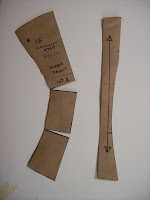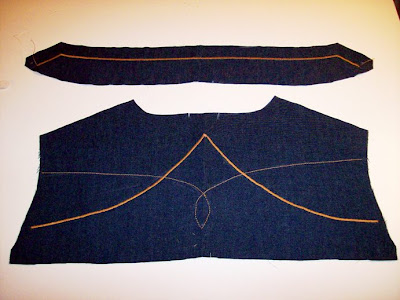I worked on Wednesday, as planned, but got wildly distracted between work sections, so only got in three of five planned pomodoros. I needed to make up those two missed timer sessions to be on track, so I did so tonight. I finished my pattern grade, and wow, hard to tell if the pictures are useful. Only one of them is actually bad.
At last entry, I had finished copying the commercial pattern, and had cut it out sans seam allowances. Now, I needed to enlarge the pattern by a certain amount to fit, as I am somewhat larger than the biggest size on the pattern. Somewhere
in a previous post I discussed how much the pattern needed to be changed. I had to enlarge each side of four seams by 5/8" at the bust, 7/"8 at the waist, and a scant 1/2" at the hip. This is a bit of an issue, since this particular pattern doesn't have a waistline indicated on the original, and the bottom edge of the garment is well above the place where you would take a hip measurement. I also know that I'm likely to need more length, as my -ahem- voluptuous figure will need more fabric to cover my larger bust, hips, and seat. I also know that some of the seam lengths may not match up exactly any more. Those little details... well, they'll get worked out at the first fitting. That'll be tomorrow afternoon.
In the meantime, let us return to stretching the pattern pieces to accommodate my measurements. I used slash and spread, and did it in a very rudimentary fashion. If the garment had things like... oh, armholes or a neckline, I might have had to take a little more time and effort. But since it doesn't, it was actually relatively easy to grade up. I experimented a bit with fancy cutting of the pattern (you'll see this below) but for the most part found I could just as easily work by simply splitting the pattern up the middle and moving each half over the specified amounts at the specified places.
For each piece, I started out by drawing some landmarks on both the underlying pattern paper and on the copied pattern piece. I often use the grainline vertically and any notches as horizontal marker points, although this isn't set in stone as sometimes the notches were pretty close together. This isn't the best picture, since I had not yet placed, horizontal guidelines, but you get the idea:
Next, the pattern piece is cut vertically. Some folks also like to make fancy horizontal cuts so that the edge can just be kind of bent out to where it needs to be. I only did that on this one piece, and found it to be a fail with this particular pattern because the side seams just got weird and bumpy. I did, however, take a picture to demonstrate the concept:
 |
| left half has horizontal cuts to allow side to flex |
 |
| detail showing how slashes allow pattern to be reshaped |
With the pattern made flexy by cutting *almost* to the edge, in theory you can just pull the whole edge to the new widths needed and blend any curves that need it. With this particular pattern, I had better luck just spreading the pattern parts, and, using my trusty grid ruler at the centerline, moving it out and marking key points. Then I redrew the new seams with a French curve. Have a look at a couple of the pieces:
Last time you may recall a picture of the copied pieces laid side by side. You could see some pretty dramatic negative space in the curve of the waist. The new grade reduces that quite a bit, as I'm pretty thick in the middle; some of the new side seams are all but straight. I am not shocked.
 |
| The complete graded pattern, laid out in order |
I will trace this new pattern directly onto canvas drill in pencil, and then add 1" allowances at the top and center front, 1/2" allowances at the seams, and a 2" allowance at the center back marked in inches to allow for the 2" gap between the edges on the finished corset. This will get its vertical seams sewn and will be fitted with the seam allowances to the outside. Any change (and I predict many) will be drawn right onto the muslin, and then transferred onto the pattern. My mother's coming over tomorrow at 3 to help, as it is virtually impossible to do a good job fitting yourself. She's not an expert seamstress, but she knows enough to lend a hand here.
I expect a second fitting will be needed before I feel ready to order steel bones or cut a garment out of expensive coutil. I also MUST finish the foundation garments before I can reasonably expect to fit the fashion garments, so this project must move on at a decent pace.
I am also planning to get in some drawing time this weekend. I intend to draw a minimum of five designs with the fabric I have on hand or can obtain relatively cheaply. I have a mind to use the beautiful purple boucle and matching plum pinstripe I have been hoarding, but also have a nice piece of navy wool, and a ton of leftover green suiting. I could also easily use black and red, though I find the combo to be a little cliche these days, as black bottomweight can be had for a song and I have some very nice accent materials on hand, including some red on black pin. Additionally, I have considered doing a piece in denim (again, inexpensive) and caramel; this would probably be the most apt to adapt for the SteamCon II "Weird Weird West" theme. I'll have to start drawing and see what I come up with.











